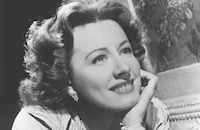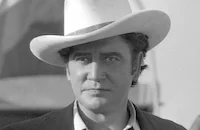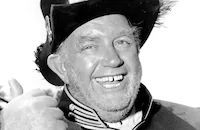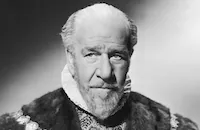Stingaree

Brief Synopsis
Cast & Crew
William Wellman
Irene Dunne
Richard Dix
Mary Boland
Conway Tearle
Andy Devine
Film Details
Technical Specs

Synopsis
In 1874, in the Australian outback, police inspector Radford chats with wealthy sheepman Hugh Clarkson and his wife about Stingaree, the country's prized outlaw. Everyone, including Hilda Bouverie, the Clarkson's maid who has been with the family since her father's death four years before, is anticipating the arrival of Sir Julian Kent, a famous London composer. Mrs. Clarkson hopes Sir Julian will launch her career as a singer, although her vocal talents leave the servants and Mr. Clarkson on edge. At the Munnedah Bar and Stage Depot, the inebriated Radford greets Sir Julian, who arrives by stagecoach. The music-loving Stingaree, who is masquerading as "Mr. Smithson," an importer of musical instruments, enters and begins a conversation with Sir Julian about current events in London. With his valet and companion, Howie, Stingaree then abducts and flees with Sir Julian. The next day, as the Clarksons leave to meet Sir Julian, unaware he has been kidnapped, Stingaree arrives at the house and overhears Hilda singing at the piano. She mistakes Stingaree for Sir Julian, and impressed by her musical proficiency, he agrees to help her train her voice without revealing his true identity. Their attraction to each other grows as Hilda explains that her late mother had been a professional singer, but had abandoned her career to be with her husband. When Hilda innocently introduces Stingaree as Sir Julian, he struggles to explain to the Clarksons his "escape" from the two outlaws. While the now-sober Radford confides to Hilda that it is Stingaree who is her guest, Stingaree repeats the information he extracted from Sir Julian the previous night in order to endear himself to the Clarksons. Once uncovered, Stingaree flees with Hilda and discovers from Howie that Sir Juilan really has escaped. Stingaree returns with Hilda that night to a party honoring Sir Julian and forces the guests to listen to her voice. Stingaree is captured, but sends word from prison that Hilda must gain her freedom from her servant life and leave with Sir Julian, who has agreed to train her voice and manage her operatic career. Following successes in Italy, Brussels, Paris, Berlin and at Covent Gardens in London, particularly in the title role of Martha , Hilda falls in love with Sir Julian and plans to marry him. On the eve of their honeymoon, however, Hilda realizes that she must return to Stingaree and forsake her career. She agrees to Sir Julian's request for a final concert in Melbourne, where she is poorly received until Stingaree, who is recently escaped from prison, arrives, masquerading as the newly appointed governor general. Stingaree's disguise is unmasked as Hilda sings "Tonight Is Mine," and he flees through the stage door. Later, in her room at the governor's residence, Hilda welcomes Stingaree through the window. As the police close in, they kiss and leave together on horseback, accompanied by Howie.

Director

William Wellman
Cast

Irene Dunne

Richard Dix

Mary Boland
Conway Tearle

Andy Devine

Henry Stephenson
George Barraud

Una O'connor
Snub Pollard

Reginald Owen

Bill Bevan
Robert Greig
Frank Dunn
Edgar Norton
Lionel Belmore
Gordon De Main
Rolfe Sedan
Keith Kenneth
Ralph Fitzsimmons
Allen Lee
Jack Kennedy
Jack Lendell
Hank Potts
Howard Hickey
Earl Covert
Norma Adoree
Adrienne D'ambricourt
Georges Renavent
Robert Adair
Luis Alberni
Alice Ardell
Patty James
Ben Hendricks
James Warwick
Carl Gordon
Frank Baker
Silver Harr
Roger Cluett
Harrington Reynolds
Arthur Clayton
Dan Dix
Sailor Vincent
John Connan
Joe Garion

Ivan Simpson
Dick Lancaster
Harry Harris
Jack Ranier
May Beatty
Carol Tevis
Crew
J. O. Aalberg
Slim Ackerman
Marcella Arnold
Carl Axcelle
Pandro S. Berman
Paul Bristow
Joe Bulch
Kenny Cooper
Merian C. Cooper
Claire Cramer
Walter Daniels
Dan Dix
Edward Eliscu
Jim Fields
Garrett Fort
Becky Gardiner
Fred Gilman
John C. Grubb
Franke Harling
Fred Hendrickson
Al Herman
Gwen Holden
Louis Jennings
Agnes Christine Johnston
Gordon Jones
Gus Kahn
David Lewis
Jack Lindall
Thomas Little
George Lollier
Cliff Lyons
Mary Miner
James B. Morley
Walter Plunkett
Van Nest Polglase
Lynn Riggs
Wells Root
John Sherwood
Anita Speer
Leonard Spigelgass
Murray Spivack
Max Steiner
Max Steiner
Dwight Taylor
Ivan Thomas
John E. Tribby
James Van Trees Jr.
James Van Trees
Vernon L. Walker
Homer Watson
C. J. White
Ralph Wildman
Dolph Zimmer

Photo Collections
Videos
Movie Clip




Film Details
Technical Specs

Articles
Stingaree
The film, made three years after Dunne had become a major star opposite Richard Dix in RKO's hugely successful Cimarron (1931), again casts her opposite that studio's most dashing leading man of the day. Stingaree was Dunne's first film showcase as a singer, to be followed by Sweet Adeline (1934), Roberta (1935), Show Boat (1936), High, Wide and Handsome (1937) and Joy of Living (1938). Although now remembered chiefly for her comedies and domestic melodramas, she was a singer of some note at this stage in her career. Closely associated with the songs of Jerome Kern, she was said to be his favorite soprano.
In Stingaree, based on the novel by E.W. Hornung, author of Raffles, Dunne plays Hilda Bouverie, a Down Under opera singer of the 1800s whose career is given a boost by the mysterious Stingaree (Dix), a bandit in the Robin Hood/Scaramouche tradition who also happens to be a songwriter. Hilda is languishing at the home of her super-rich guardian, Mrs. Clarkson (the hilarious Mary Boland), a would-be diva who fancies herself a terrific singer even though her voice is enough to sour the milk. Impersonating the composer Sir Julian Kent (Conway Tearle) and inspired by Hilda's lovely voice, Stingaree gifts her with one of his own compositions, "Tonight Is Mine," which eventually will help her win international fame. Later, during a homecoming concert in Melbourne, a very willing Hilda is kidnapped by Stingaree, who by now has won her heart.
On hand in the supporting cast are Andy Devine, then in his twenties but already in raspy-voiced sidekick mode; dependable character actors Henry Stephenson and Reginald Owen, both of whom also appear in Double Harness (1933), another of the "lost" RKO films; and the delightful Una O'Connor, who specialized in playing impudent maids and housekeepers.
Certainly one of the more unusual items in director Wellman's filmography, the boisterous Stingaree won a largely favorable notice in The New York Times by Mordaunt Hall, who commented that the movie's "impossible happenings are highly entertaining. Miss Dunne gives a charming performance and sings several songs very agreeably." The soundtrack includes two songs by Gus Kahn and W. Franke Harling, "Stingaree Ballad" and the ubiquitous "Tonight Is Mine"; two by Edward Eliscu and Max Steiner, "I Wish I Were a Fisherman" and "Once You're Mine"; and excerpts from Charles Gounod's "Faust" and Friedrich von Flotow's "Martha."
Before Dunne was cast, RKO held discussions with Jeanette MacDonald and MGM about loaning MacDonald for the role of Hilda. The Melbourne and Covent Garden opera house sequences were shot at Universal on the Phantom of the Opera stage at a rental cost of $1,500. Stingaree was first filmed in 1915 by the Kalem Company as a 12-part silent serial starring True Boardman and Marin Sais and directed by James W. Horne.
Producer: Pandro S. Berman, David Lewis
Director: William A. Wellman
Screenplay: Becky Gardiner, Lynn Riggs, Leonard Spigelgass, from novel by E.W. Hornung
Cinematography: James Van Trees
Film Editing: James B. Morley
Art Direction: Van Nest Polglase, Alfred Herman
Original Music: Edward Eliscu, W. Franke Harling, Gus Kahn, Max Steiner
Costume Design: Walter Plunkett
Principal Cast: Irene Dunne (Hilda Bouverie), Richard Dix (Stingaree, aka Mr. Smithson), Mary Boland (Mrs. Clarkson), Conway Tearle (Sir Julian Kent), Andy Devine (Howie), Henry Stephenson (Mr. Hugh Clarkson), Una O'Connor (Annie), George Barraud (Inspector Radford), Reginald Owen (Governor-General), "Snub" Pollard (Victor).
BW-77m. Closed captioning.
by Roger Fristoe

Stingaree
Quotes
Trivia
Notes
Although onscreen credits indicate that the film was based on a series of Hornung "stories," Hornung wrote a novel called Stingaree, which probably provided some if not most of the film's narrative. The Variety review notes that excerpts from Charles François Gounod's Faust and Friedrich Flotow's Martha: Oder der Markt von Richmond are "introduced as parts of the mimic stage performance." RKO borrowed cameramen James Van Trees, James Van Trees, Jr. and Louis Jennings from Fox. A June 1933 Hollywood Reporter pre-production news item announced Dorothy Wilson as a "featured" cast member, but her appearance in the final film is doubtful. According to another Hollywood Reporter news item, Leslie Banks was also cast, but he was not in the released film.
According to RKO production files, exteriors were shot at the Edgar Rice Burroughs Ranch and at the Tarzana Golf Course in Tarzana, CA, and in Sherwood Forest, CA. In addition, scenes set in the Melbourne Opera House were filmed on the Phantom of the Opera set at Universal Studios. RKO production files indicate that Joseph I. Breen, Director of Public Relations for the Hays Office, requested many changes and deletions in the script before approving the film. In letters to RKO executive Merian C. Cooper, dating from 21 January to April 10, 1934, Breen asked that many lines and words with questionable connotations, such as "Perhaps Stingaree has got him in a ditch with his pants down" and "She goes to bed with Dizzy's plans and wakes up filled with an empire," be deleted. Hornung's story was first filmed as a twelve-episode silent serial, produced by the Kalem Company and called The Adventures of Stingaree.
Stingaree was one of six RKO films broadcast on the Turner Classic Movies (TCM) network in April 2007 after not being publicly screened for decades. For information on issues involving the rights and restoration of these pictures, please consult the entry above for Double Harness.














